Darcygom, a fashion brand launched by designer Sung Ju Beth Lee, is inspired by tradition. Befitting its name, which comes from an old Korean word meaning “once again,” it presents modern interpretations of hanbok — the traditional Korean dress — and fashion pieces made with upcycled materials.
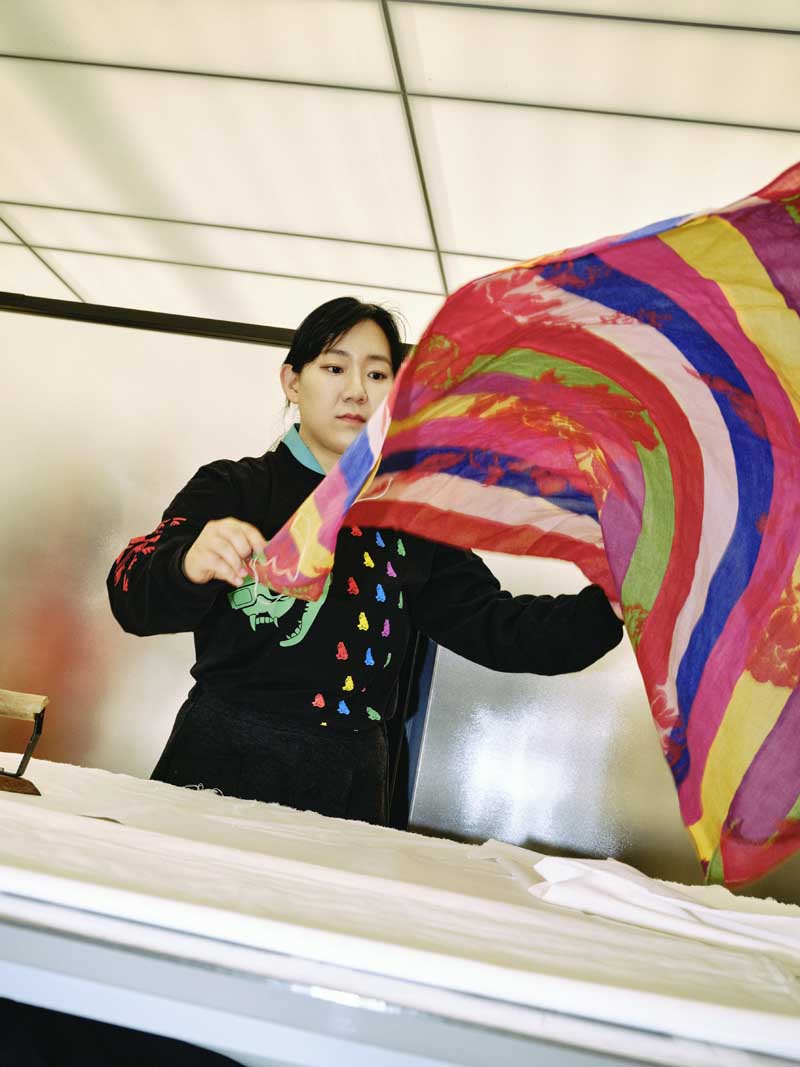
Saddened that saekdong, a traditional multicolor fabric, is at risk of fading into history, Sung Ju Beth Lee seeks to make it more accessible by incorporating it into her designs in a modern way.
Designer Sung Ju Beth Lee reimagines tradition with a modern sensibility. For her fashion brand Darcygom, she infuses traditional elements with wit and eccentricity, coming up with unconventional pieces — a bag modeled after jeongjagwan, a traditional indoor hat worn by classical scholars; a jumpsuit with a neckline inspired by the collar strip of jeogori, the upper piece of hanbok; and sneakers made with saekdong, a traditional multicolor striped fabric. She also focuses on making fashion sustainable through upcycling. The brand name “Darcygom,” which comes from an old Korean word meaning “once again,” embodies the values Lee pursues in fashion: reviving the old and reinterpreting it to create something new.
Lee lived abroad for 17 years, in the United States, Canada, Germany, and Tanzania. She had no background or experience in fashion. However, after returning to Korea, she decided to visit Gwangjang Market in Seoul, known for hanbok and bedding, to learn how to make clothes. Since launching Darcygom in 2017, Lee has continued to expand her design horizons, collaborating with Korean companies such as Otoki and Cass Beer, as well as the Asian Art Museum of San Francisco and London’s Victoria and Albert Museum, launching her products in their stores.
You’ve gone from complete novice to having your own brand.
The last place I lived abroad was Tanzania. I had to quit my job there and return to Korea due to deteriorating health. Unable to work, I began thinking about my future and decided I should try something new. I’d collected traditional fabrics and garments from the various countries I’d traveled to — áo dài from Vietnam, yukata from Japan. But I realized I didn’t own a single hanbok. I headed straight to Gwangjang Market and asked if there was anyone who could teach me how to sew. The people there thought I was strange, but I found a seamstress who was willing. I also took classes at Seoul Design Foundation and the Korean Advanced Sewing Skills Academy, operated by the Seoul Metropolitan Government. One thing led to another, and eventually, I launched my own brand. It all happened by chance.
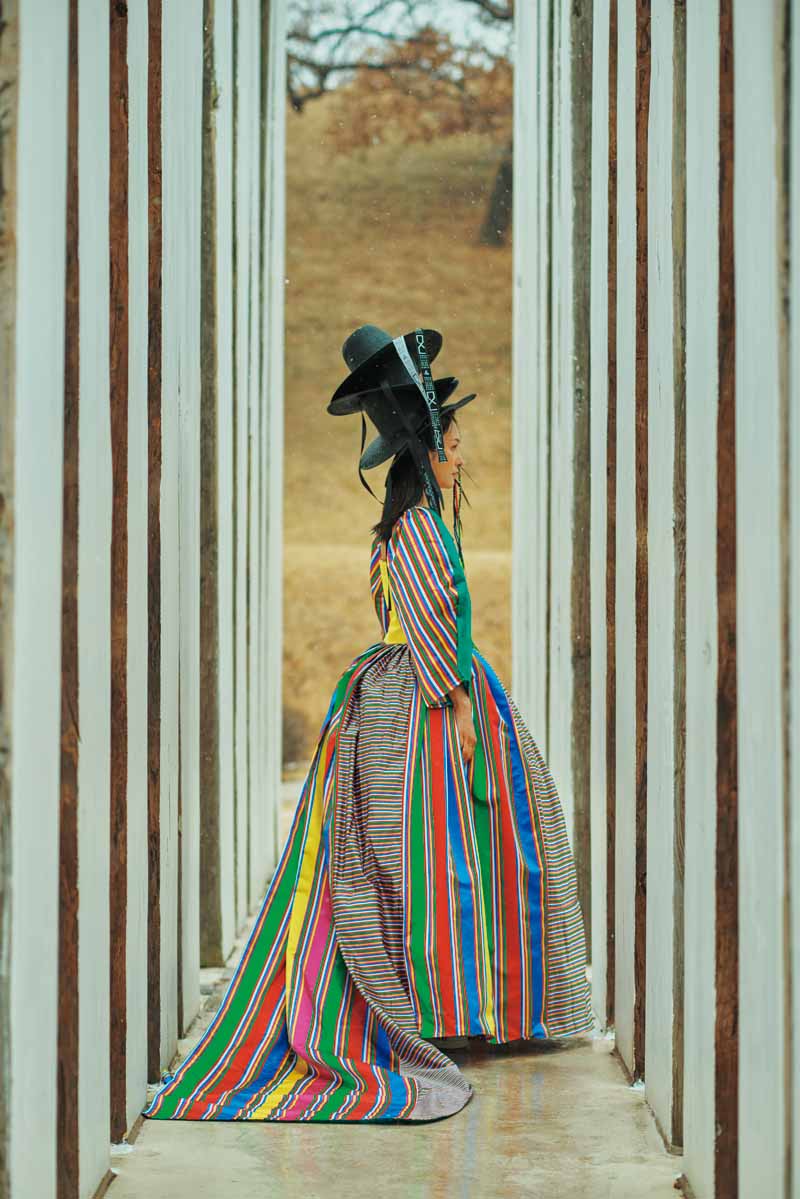
A project showcasing combinations of saekdong in various thicknesses and colors, featured in American lifestyle publication Red Hot Monde Magazine in 2021.
© OH Seungjune
What are your childhood memories of hanbok?
I spent my childhood in North America. I wore a hanbok for the first time when I was around four or five. It was red and orange with rose patterns. Thinking about it now, it was kind of tacky, but back then, to my young eyes, it was beautiful — fit for a princess. I liked it so much, I was worried I would grow out of it. You develop a longing for your homeland when you live in a foreign country. My younger brother fell in love with Korean food; for me, I think my nostalgia surfaced in clothing.
Why do you find saekdong so appealing?
I have an attachment to things that are dying out and fading from memory. When I was searching for saekdong at Gwangjang Market, I found out that there was only one place left in the entire country that still makes it. Supply had nearly vanished due to dwindling demand. It saddened me to see a valuable part of our cultural heritage at risk of disappearing into history, so I began working with the fabric. Fortunately, the response was favorable, and I was able to incorporate it into various designs. Like my brand’s name, it was an experience of reviving something “once again.” Some people were drawn to saekdong’s vivid colors, while many others liked that it sparked feelings of nostalgia.
How did you team up with the Ambiguous Dance Company?
In 2020, the Korean Ministry of Culture, Sports and Tourism hosted a competition themed on hanbok in connection with Hallyu [the Korean Wave]. Most of the contestants collaborated with K-pop idols, but I thought immediately of the Ambiguous Dance Company. I was a big fan. Luckily, my proposal was selected, and this led to the launch of the Spring/Summer 2021 collection titled “Ambiguous Jungle.”
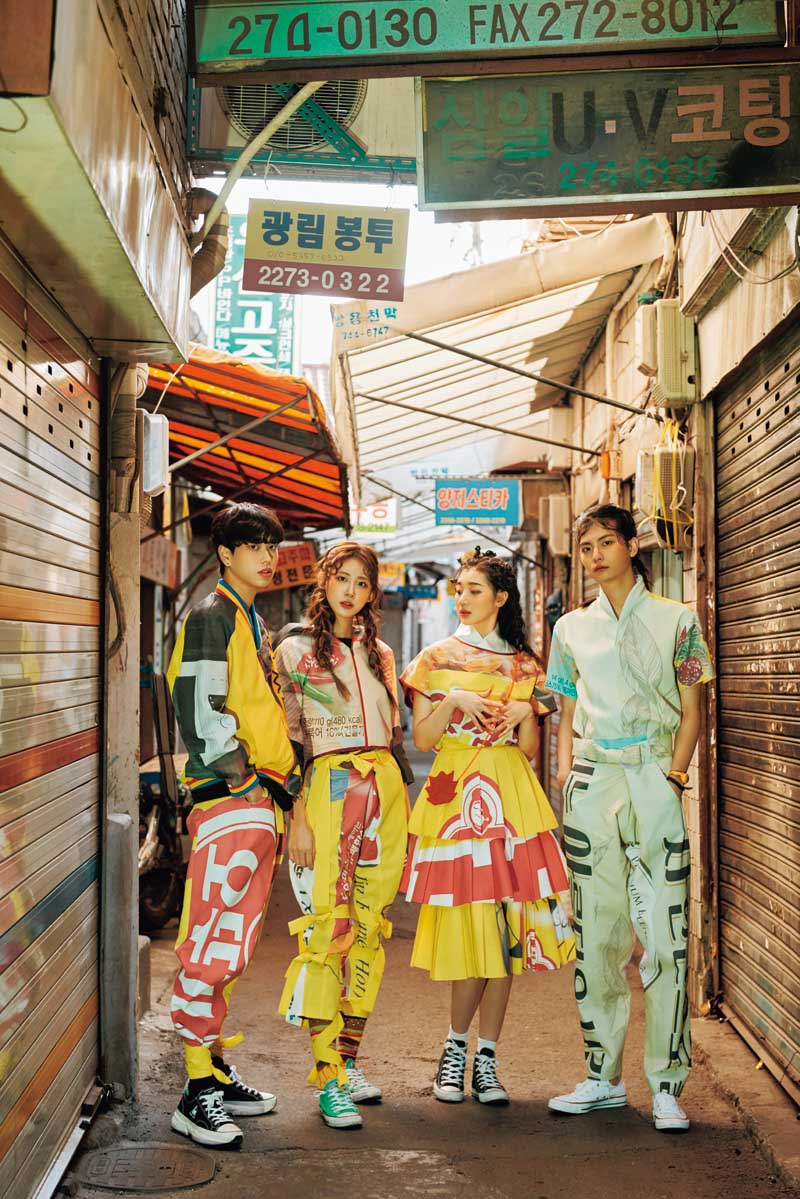
A collaborative project with food manufacturing company Otoki, which provided the banners used to make the clothes.
© OH Seungjune
What’s most important in modernizing traditional elements?
First, it has to be fun. If it isn’t fun, it’s agonizing. There are plenty of designers who already make elegant, beautiful clothes. For me, storytelling is important. I begin working only when I have something I want to say. I believe a design should convey an interesting story. Next is practicality. I ask myself questions like, “Could I ride the subway in this outfit?” The top I’m wearing now underneath is a functional garment made of thermal fabric, with the neckline in the style of a hanbok jacket. Darcygom is all about combining traditional motifs and style with functionality.
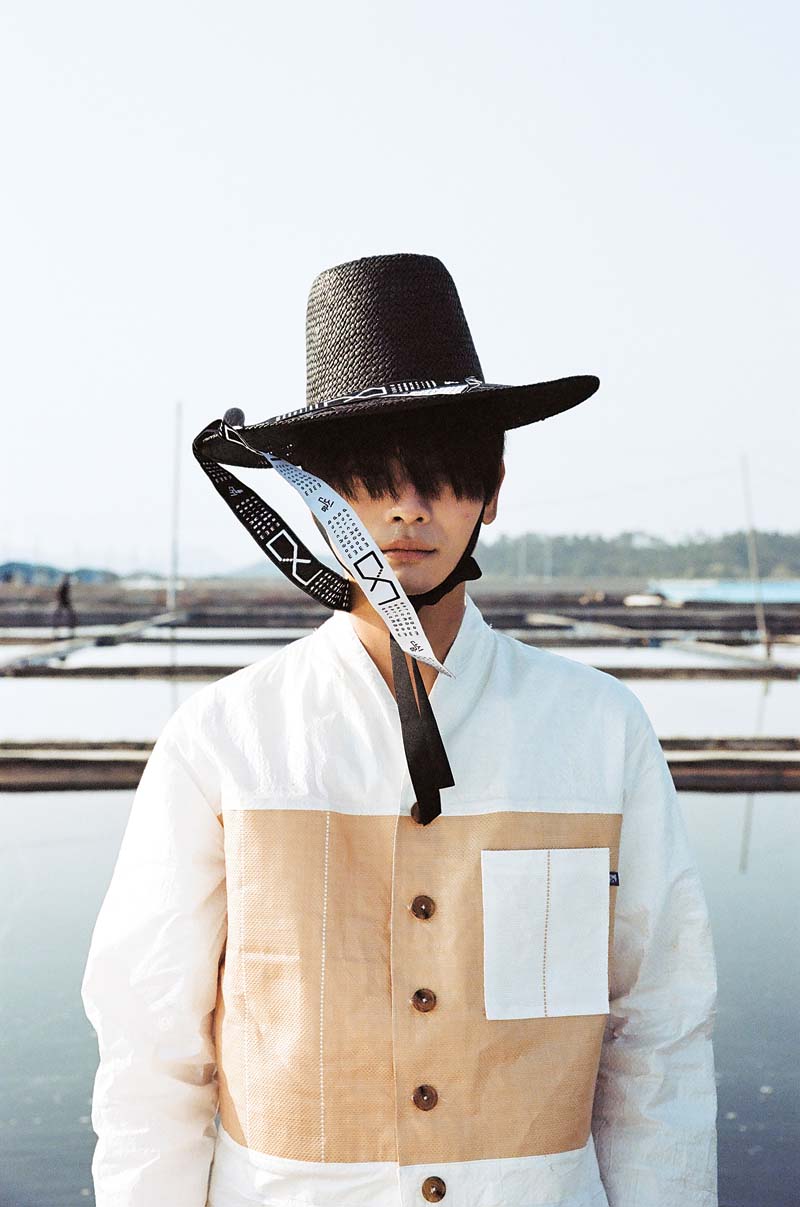
Though durable, salt sacks are usually discarded after a single use due to logistics costs. This garment was made with upcycled salt sacks from Bigeumdo, an island in Sinan County, Korea’s largest sun-dried sea salt producer.
© JUNG Ji Hoon
Is “fun” behind the quirky names of your accessories?
I gave my bags names like “Nolbu” and “Gat.” Nolbu is the greedy, ill-tempered older brother from the Korean folk tale Heungbu and Nolbu. In the story, he’s depicted as wearing a jeongjagwan, a traditional men’s hat worn at home by classical scholars of the Joseon Dynasty. It was the inspiration for the bag’s design. I named it “Nolbu” because I didn’t think anyone would remember “Jeongjagwan,” and thought many people would relate to the name when they saw the bag’s pointed shape. The Gat bag was modeled after the gat, a traditional men’s formal hat. It’s a fun name that sounds like “God” and just rolls off the tongue.
How can traditional garments be adjusted to suit today’s body types?
One beautiful feature of hanbok is the natural folds. They complement the body and allow for ease of movement. This is harder to achieve through draping, which is why I prefer flat pattern cutting for my designs.
What do you focus on in your upcycled designs?
Usually, I create a design first and then look for the right fabric. But with upcycling, I start with the materials I’m going to work with. I try to look for outlandish materials. When I was young, I enjoyed watching the reality fashion show Project Runway. I would get a kick out of seeing the contestants conquer the most outrageous challenges. There are times when I also approach a project as if it were a challenge. Once, I made clothes out of the seat covers I took from my friend’s scrapped car. And there’s no shortage of discarded [cloth] banners — the amount of banners companies use for events is truly staggering. That’s why I find collaborating with companies on these upcycling projects so gratifying.
How did you start collaborating with museums abroad?
After seeing my collaboration with Otoki, the Victoria and Albert Museum approached me, proposing to sell some of my products in their museum stores. After that, I also got to work on a collaborative project with the Asian Art Museum of San Francisco. I think they found my work interesting.
What does it mean to describe something as “Korean”?
People of my generation might have memories of the Del Monte orange juice bottle. Back in the day, Koreans used to store barley tea in the [glass] bottle after finishing the juice. For a while, the tea would have a lingering taste of orange. I think that’s what “Korean” means. It’s something vague that stays with you — nothing essential to getting through the day, but something that continues to remain a part of you.
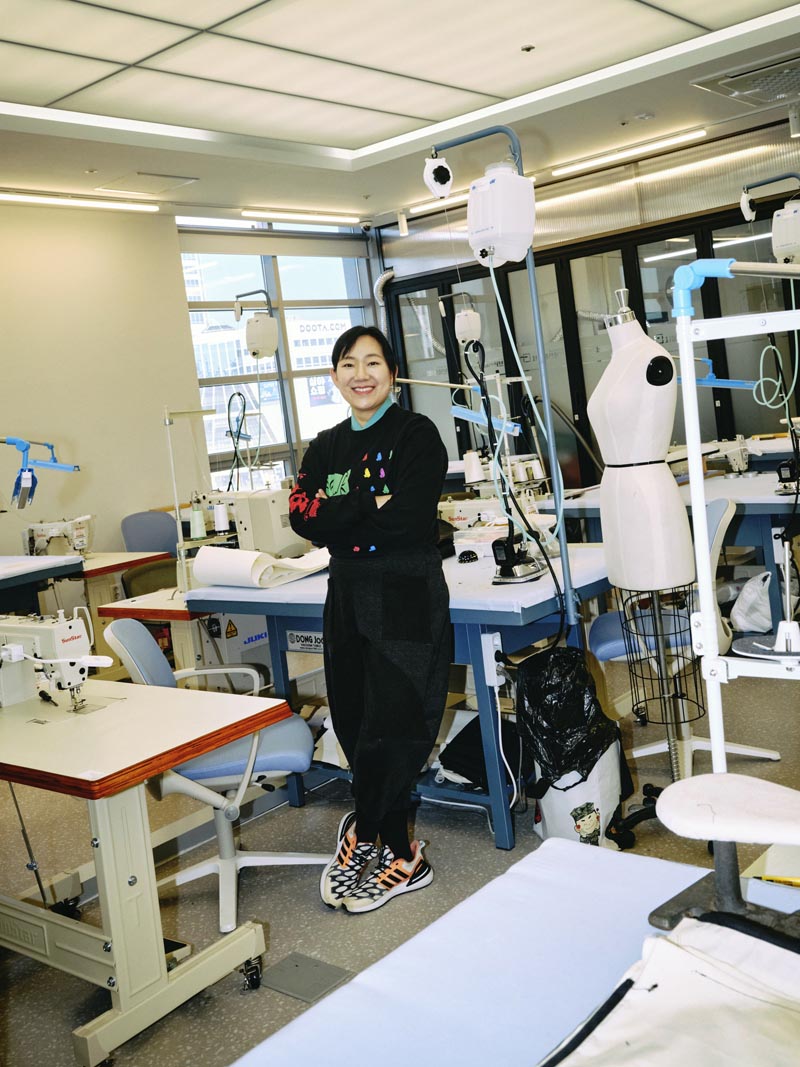
Lee poses in the sewing workshop at Seoul Fashion Hub in Dongdaemun. She aspires to make fashion sustainable through upcycling and modern interpretations of traditional elements.